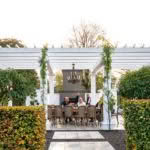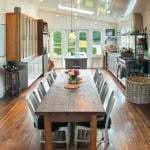Meet the couple ushering this historic home and garden into the modern era
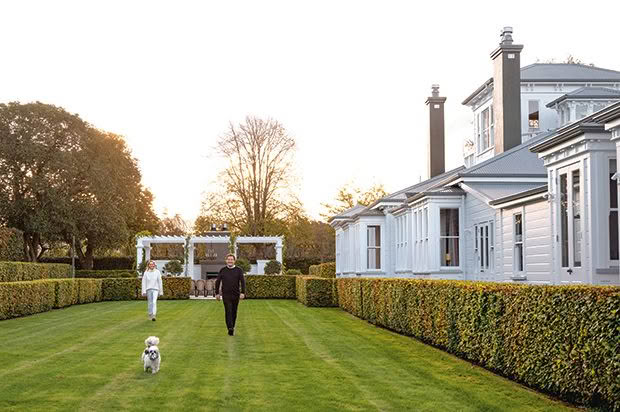
Tim Clarke and Tessa O’Rorke’s four-hectare property, Richmond Estate, is all about hedges and edges; on the south side of the house, a vast formal lawn is flanked by hornbeam behaving impeccably. Tessa’s dog, Miss Indie, a lhasa apso, is her constant shadow.
One of the country’s leading gardens is entering a new phase in the hands of a Wellington lawyer and his design-focused partner.
Words: Kate Coughlan Photos: Esther Bunning
Richmond Garden (now called Richmond Estate), a famous Carterton property developed by Melanie and John Greenwood, was assessed in its early years by the New Zealand Gardens Trust as a Garden of International Significance, one of only four in that category at the time. The design’s allegiance to the formal Italian Renaissance style — with a central axis linking the house to linear perspectives — is precise and extensive. It isn’t a garden for the faint-hearted nor a property with which to trifle.
And Tim Clarke had no intention of falling in love with such a singular property when he went looking for a house near enough to Wellington for him and his family (and daughter Amy’s horses) to spend weekends. The stables, grazing paddocks and dressage arena were all there — tick. The house was roomy enough to accommodate Tim and family, plus all the friends he knew would join them for weekends — tick. Tennis court — tick. Swimming pool — tick. And Carterton, always at least two degrees warmer than Wellington and just 75 minutes away — tick. But what about the garden?
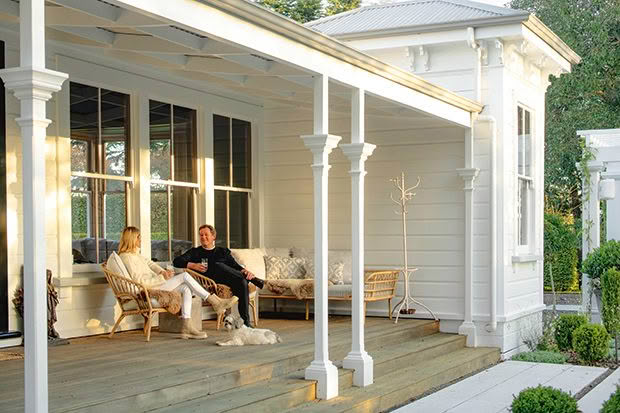
The deep verandah on the house’s west side is a relaxed and sunny spot — no doubt like it was in the days of its original owner, Henry Wolters, Carterton’s first town clerk, who named it after Richmond Palace near his birthplace in the Duchy of Brunswick in northwest Germany. The palace was built in 1765 for the third daughter of King George III, Princess Augusta. She named it for her previous home near London’s Richmond Park, a renowned landscape featuring long avenues of formally planted trees.
The term “unified geometry” might roll easily off the tongue, but how to keep kilometres of trees and shrubs obeying the instruction to remain geometrically unified? Tim, who’d grown up in the Bay of Plenty with excellent gardeners on both sides of his family, recognised it as a property in another order of magnitude when it came to maintenance.
“I was reassured by Melanie and John that it is not as much work as it appears,” he recalls of considering the heart-stopping prospect of keeping it all perfectly just so.
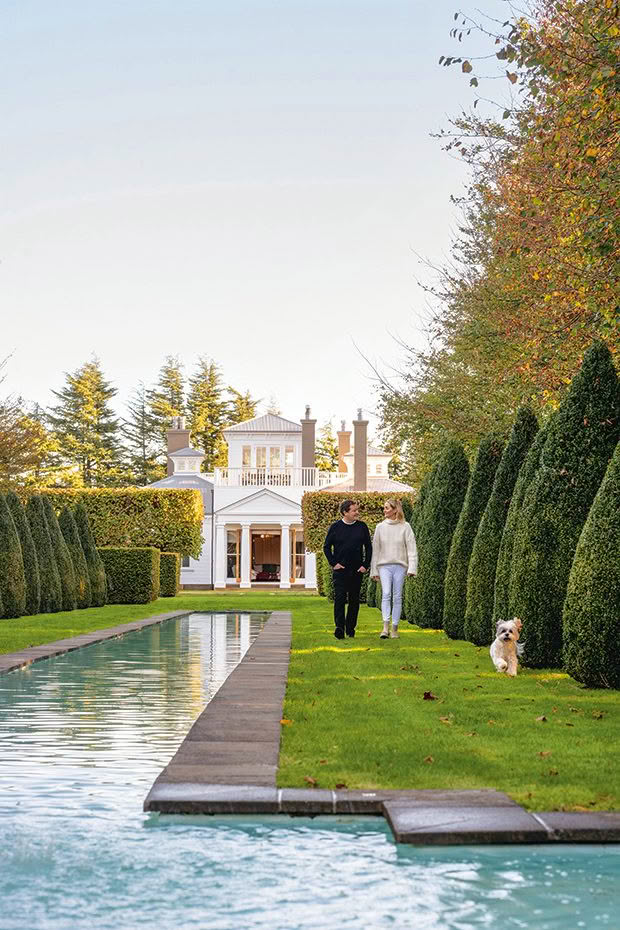
They were right, and the gardening team from Dirty Work ensure that even now, nine years later, the property retains the precision that is its defining characteristic. The four hectares take 40 hours a week of regular attention and a thrice-yearly mammoth team effort over several days to trim and prune hedges, edges, trees and shrubs.
“I fell in love with it the first time I saw it, even though it isn’t what I expected to buy.”

Clipped yews flank the pond; the fountain at its axis is the primary visual element seen from the front of the house. The green architecture of such a formal garden is all about symmetry. Plantings are always massed and repeated; yews, buxus and ilex provide the main clipped structures, woodland trees are planted in grid patterns, limes are pleached and hornbeam and english beech are hedged. Everything is clipped and trimmed three times a year.
Tim, a lawyer, took a breath and reminded himself of how much he admired Italian Renaissance art and architecture, New Zealand history and everything about the Enlightenment philosophy the garden embodies. Then he purchased it. He hasn’t looked back, finding no need to change it until now. The evolution of the property is primarily the impetus of his partner of the past three years, Tessa O’Rorke, who has a degree in design from AUT. (Although her career most recently has been in executive roles in the technology sector in private and publicly listed companies.)
- The hall is a deterrent to casually offering to fetch an early morning cup of tea —the main bedroom is 20 metres from the kitchen. It provides a workout when Tessa has guests to feed. Here, she and her friend Kate Johnson share the load.
- The couple was initially taken aback when new Palladian columns were erected for their outdoor dining area, thinking they’d gone too big. However, they’re happy now as the space feels right against the backdrop of the imposing house.
- The cosy heart of the home is the kitchen — with its open fire, many windows and commercial espresso machine, it is usually full of guests.
“Fair to say that I am more resistant to change than Tessa, and I was happy just keeping it exactly as it was,” he says. However, today Tim is a contented and converted co-conspirator in three major projects that, during the past year, have seen Tessa initiate the transformation of a formal sitting room into a library, develop a large meandering native garden of 1500 plants — without one straight line — and along with design input from landscaper Hamish Moorhead, create a large outdoor living area near the swimming pool.
“What I’ve aimed to accomplish is enhancing the liveability of the property while maintaining the utmost respect for its historical significance and the integrity of the garden,” says Tessa.
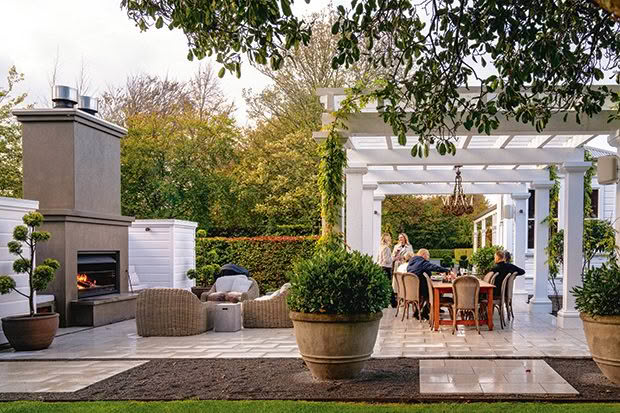
Warm afternoons are spent outside in the new outdoor living area, designed with outstanding input from Wairarapa-based landscape architect Hamish Moorhead.
Although Tim and Tessa haven’t opened the garden to the public (it is no longer part of the New Zealand Gardens Trust), they have occasionally made it available over the years for various events, including the Wairarapa Garden Tour (for the Pūkaha National Wildlife Centre), the Kokomai Arts Festival and fundraisers for the Carterton Foodbank.
Last year, the couple hosted a friend’s wedding on the grounds, and it lit a spark for Tessa, who began to wonder if weddings could become a more regular feature. Over the summer past, she and Tim mulled it over and then committed to opening Richmond as a venue for a handful of weddings each year.
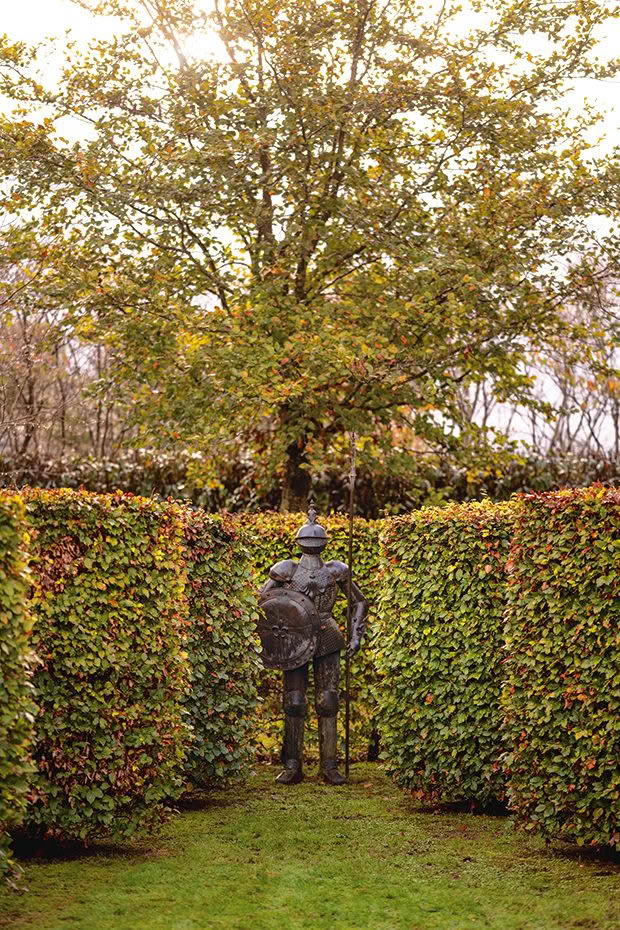
Every window in the house is “planted” for the viewer’s eye to be taken somewhere; a suit of armour, which can be seen from the library, is strategically placed between hornbeam hedging.
“The guests at our friends’ wedding were effusive. They loved the property, and it was an ideal location. We won’t have many, keeping it very boutique, with perhaps four or five a year,” says Tessa.
She is developing the wedding venue brand Richmond Estate and is excitedly in the middle of launching her new business venture. “I intend to share the beauty of this property with people on one of the most special days of their lives.”
- To the east of the main living areas, is a two-bedroom guest house in regular use with family and friends finding reasons for a country weekend.
Tim is thrilled that Tessa’s creativity has found a use for their spectacular property and that more people will be able to enjoy it in a new iteration.
“Nothing ever stays the same. The original house dates to the 1880s and was built by Henry Wolters, who married into Wellington’s well-known Beauchamp family. So, Katherine Mansfield [a Beauchamp] is believed to have been an early visitor here.”

The walls of the library and stud-height book shelves, painted in Dulux’s Cool Current, are a drawcard for guests who gravitate towards the fire with their books and settle in.
The main house, a combination of two pushed together in the early 1900s, faces the garden’s central axis, leading to the ornate and huge Italianate fountain. The relationship between house and garden is strong, with every window looking out to a symmetrical planting of trees or shrubs. The previous owners restored the facade to enhance its Palladian presence. Alongside the east wing, a smaller cottage was adjoined to provide independent two-bedroom accommodation for family and friends who do, as predicted, tend to flock over the hill for Carterton weekends.
“It is a rare weekend for us not to have friends staying,” says Tessa. “The highest overnight head count is 20 guests.”
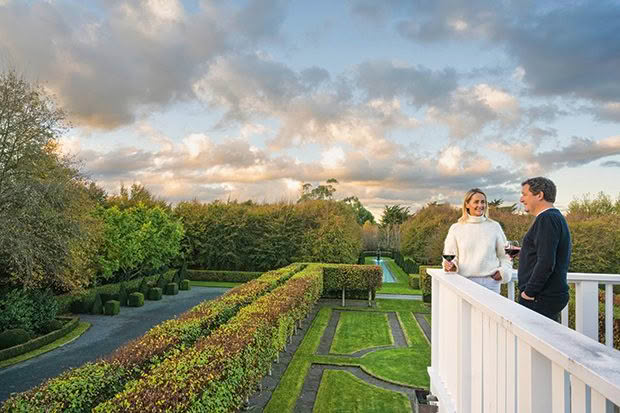
An observation tower and large balcony above the formal sitting room is an excellent spot from which to appreciate the extent of the formal planting.
Says Tim: “The best thing about this place is being able to share it with other people, and the house is large enough to swallow them up without us all being too much on top of each other. I love seeing people arrive and watching them visibly relax and unwind. Even though it is a big house, it is still very much a family home in its proportions and how it feels.
“Sitting in front of one of the fires [all eight are operational] with a glass of good red wine and a book does wonders for people.”
Love this story? Subscribe now!
 This article first appeared in NZ Life & Leisure Magazine.
This article first appeared in NZ Life & Leisure Magazine.


